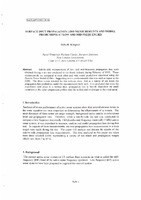| dc.contributor.author | Klingbeil, Delia H. | |
| dc.date.accessioned | 2018-10-11T14:05:38Z | |
| dc.date.available | 2018-10-11T14:05:38Z | |
| dc.date.issued | 1993/08 | |
| dc.identifier | 794 | |
| dc.identifier.govdoc | CP-42/1 | |
| dc.identifier.uri | http://hdl.handle.net/20.500.12489/128 | |
| dc.description.abstract | Side-by-side measurements of low- and mid-frequency propagation loss were obtained during a sea test conducted in the North Atlantic during February of 1992. These measurements are compared to each other and with model predictions calculated using the Generic Sonar Model (GSM). Supporting in-situ environmental data was used as inputs to the GSM. The three events selected for this analysis show. that in a variety of sea states the propagation loss predictions model the measurements fairly well. It is concluded that since the experimellt look place ill a surface dueL propagation loss is heavily dependent on small variations in lhe waler temperature profiles near the surface and on changes in the wind speed. | |
| dc.format | 16 p. : ill., 17 fig. ; digital, PDF file | |
| dc.language | English | |
| dc.publisher | NATO. SACLANTCEN | |
| dc.source | In: Low frequency active sonar (SACLANTCEN Conference Proceedings CP-42), vol. 1, 1993, pp. B/8-1 - B/8-16. | |
| dc.subject | Acoustic propagation | |
| dc.subject | Transmission loss measurements | |
| dc.subject | Modelling and environmental measurements | |
| dc.subject | Low frequency acoustics | |
| dc.subject | Mid frequency acoustics | |
| dc.subject | Sonar mathematical models | |
| dc.title | Surface duct propagation loss measurements and model predictions at low and mid frequencies | |
| dc.type | Papers and Articles | |
| dc.type | Conference Proceedings (CP) | |
